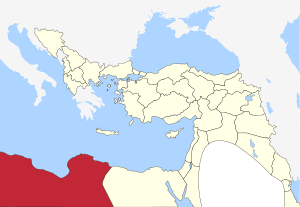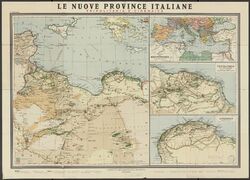ولاية طرابلس غرب
| ولايت طرابلس غرب Vilâyet-i Trâblus Gârp | |||||||
|---|---|---|---|---|---|---|---|
| إيالة، ولاية الدولة العثمانية | |||||||
| 1551–1911 | |||||||
 Flag of the Ottoman Empire (1453-1844)[1] | |||||||
 إيالة طرابلس غرب عام 1900 | |||||||
| العاصمة | طرابلس | ||||||
| التاريخ | |||||||
| التاريخ | |||||||
• Established | 1551 | ||||||
| 18 أكتوبر 1911 1911 | |||||||
| |||||||
| اليوم جزء من | ليبيا | ||||||
| جزء من سلسلة عن |
| تاريخ ليبيا |
|---|
 |
| قبل التاريخ |
| التاريخ القديم (قبل 146 ق.م) |
| الحكم الروماني (146 ق.م– 640 م) |
| الحكم العربي (640–1551) |
| الحكم العثماني (1551–1911) |
| الاستعمار الإيطالي (1911–1934) |
| ليبيا الإيطالية (1934–1943) |
| احتلال الحلفاء (1943–1951) |
| مملكة ليبيا (1951–1969) |
| حكم القذافي (1969–2011) |
| الثورة الليبية (2011) |
| المجلس الانتقالي (2011–الآن) |
|
|
كانت المنطقة الساحلية التي تعرف اليوم باسم ليبيا تحت حكم الدولة العثمانية من 1551 حتى 1911، من 1864 كانت تعرف باسم إيالة طرابلس غرب. وتعرف أيضاً باسم مملكة طرابلس، بالرغم من أنها لم تكن مملكة بالفعل، لكنها كانت إيالة عثمانية يحكمها باشا (حاكم)، ثم حكمتها الأسرة القرمانلية من عام 1711 حتى 1835 كملكية وراثية بسياسة الأمر الواقع.
بالإضافة إلى الأراضي المركزية الرئيسية في طرابلس وبرقة، كانت تعتبر جزء من مملكة طرابلس لأنها كانت تحكم بسياسة الأمر الواقع وكان يحكمها باشا طرابلس.[2]
التاريخ
الفتح العثماني
في بداية القرن السادس عشر كان الساحل الليبي يتمتع بقدر ما من السلطة المركزية وكانت موانيها ملاذاً آمنا للقراصنة. احتلت إسپانيا طرابلس عام 1550، لكن الإسپان كانوا أكثر اهتماما بالسيطرة على الميناء أكثر من الأعباء التي قد تسببها السيطرة على باقي أراضي المستعمرة. في عام 1530 تنازل الملك تشارلز الأول عن طرابلس ومالطا وغودش، إلى فرسان القديس يوحنا كتعويض عن طرد الأتراك لهم من رودس. حكمها المسيحيون حتى عام 1551، عندما حاصرها وغزاها الأميرال العثماني سنان باشا ودرغوث رئيس. أعلن درغوث باي ثم فيما بعد باشا على طرابلس، Turgut Reis submitted the قبائل المناطق الداخلية والمدن المختلفة مثل مصراتة، زوارة، غريان وقفصة في العقد التالي. أسهمت تلك الجهود في ترسيخ أسس الدولة فيما يعرف اليوم باسم ليبيا، لكن لم يكن هناك سيطرة قوية من القسطنطينية مثلها مثل باقي مناطق الساحل البربري.
تحت الحكم العثماني، كانت المغرب تنقسم إلى ثلاث ولايات، الجزائر، تونس وطرابلس. بعد عام 1565، أعطيت السلطة الادارية المباشرة للباشا، الذي عينه السلطان في القسطنطينية. أرسل السلطان الباشا ومعه قوة من الإنكشارية، والتي كانت تنقسم إلى عدة سرايا تحت إمرة ضابط أو باي. سرعان ما تحول الإنكشاريون إلى قوة مهيمنة في ليبيا العثمانية. As a self-governing military guild answerable only to their own laws and protected by a divan (a council of senior officers who advised the pasha), the janissaries soon reduced the pasha to a largely ceremonial role.
الأسرة القرمانلية والحروب البربرية
عام 1711، استولى ضابط سلاح الفرسان العثماني، وابن ضابط تركي وسيدة ليبية أحمد القرمانلي على السلطة وأسس الأسرة القرمانلية، التي استمرت لمدة 124 عام. في تلك الفترة وقعت الحرب الأهلية الليبية 1793–1795. في مايو 1801 طلب الباشا يوسف القرمانلي من الولايات المتحدة زيادة مبلغ الجزية (83,000 دولار) والتي كانت تدفعها الحكومة الأمريكية منذ عام 1796 لحماية تجارتها من القرصنة. رفضت الحكومة طلبه، وقامت قوات البحرية الأمريكية بحصار طرابلس، ووقعت حرب الساحل البربري الأولى حتى 3 يونيو 1805.
حرب الساحل البربري الثانية (1815، وتعرف أيضا بالحرب الجزائرية) كانت ثاني الحروب بين الولايات المتحدة الأمريكية ومقاطعات الدولة العثمانية في شمال أفريقية؛ الجزائر، طرابلس، وتونس، والتي تعرف باسم دول الساحل البربري.
إعادة فرض النفوذ العثماني
عام 1835، استغلت حكومة السلطان محمد الثاني الاضطرابات الداخلية لاستعادة سلطتها المباشرة والتي استمرت حتى فترة تفكيك الدولة العثمانية. أدت السلطة العثمانية اللامركزية إلى الاستقلال الاسمي لمصر وطرابلس والصحراء الواقعة بينهما، وإنتشار الفوضى حتى بعد فرض السيطرة المباشرة على طرابلس. The indigenous Senussi Movement, led by Islamic cleric Sayyid Mohammed Ali as-Senussi, called on the countryside to resist Ottoman rule. The Grand Senussi established his headquarters in the oasis town of Jaghbub while his ikhwan (brothers) set up zawiyas (religious colleges or monasteries) across North Africa and brought some stability to regions not known for their submission to central authority. In line with the expressed instruction of the Grand Sanusi, these gains were made largely without any coercion.
The highpoint of the Sanusi influence came in the 1880s under the Grand Senussi's son, Muhammad al-Mahdi as-Senussi, who was a skilled administrator and a charismatic orator. With 146 lodges spanning the entire Sahara, he moved the Senussi capital to Kufra. Harsh Ottoman rule only fuelled the appeal of the Senussi Movement's call to repel foreign occupation. Remarkably, Mohammed al-Mahdi succeeded where so many had failed before him, securing the enduring loyalty of the Amazigh tribes of Cyrenaica. Over a 75 year period the Ottoman Turks provided 33 governors and Libya remained part of the empire—although at times virtually autonomous—until إيطاليا invaded in 1911, as the Ottoman Empire was collapsing.
الحرب الإيطالية التركية
The Italo-Turkish' or Turco-Italian War (also known in Italy as the Guerra di Libia, "Libyan war", and in Turkey as the Trablusgarp Savaşı, "Tripolitan war") was fought between the Ottoman Empire and the Kingdom of Italy from September 29, 1911 to October 18, 1912.
As a result of this conflict, Italy was awarded the Ottoman provinces of Tripolitania, Fezzan, and Cyrenaica. These provinces together formed what became known as Libya. During the conflict, Italian forces also occupied the Dodecanese Islands in the Aegean Sea. Italy had agreed to return the Dodecanese Islands to the Ottoman Empire according to the Treaty of Ouchy[3] in 1912 (also known as the First Treaty of Lausanne (1912), as it was signed at the Ouchy Castle in Lausanne, Switzerland).
However the vagueness of the text allowed a provisional Italian administration of the islands, and Turkey eventually renounced all claims on these islands in the Article 15 of the Treaty of Lausanne in 1923.[4] Turkey had to withdraw all its military forces and administrative agents from Libya according to Article 2 of the Treaty of Ouchy in 1912 (per Article 22 of the Treaty of Lausanne in 1923).[4]
Although minor, the war was a significant precursor of the First World War as it sparked nationalism in the Balkan states. Seeing how easily the Italians had defeated the disorganized Ottomans, the members of the Balkan League attacked the Empire before the war with Italy had ended.
The Italo-Turkish War saw numerous technological advances used in warfare, notably the aeroplane. On October 23, 1911, an Italian pilot flew over Turkish lines on a reconnaissance mission, and on November 1, the first ever aerial bomb was dropped by Sottotenente Giulio Gavotti, on Turkish troops in Libya, from an early model of Etrich Taube aircraft.[5]
التقسيمات الادارية
سناجق الإيالة في منتصف القرن التاسع عشر:[6]
|
سناجقة الإيالة:[7]
|
انظر أيضاً
المصادر
- ^ "The Karamanli-era flags have always an uneven number of horizontal stripes, alternatively red and yellow. The flags of the Tripoli Regency were hoisted on forts and armed vessels in Tripoli, Benghazi and Derna. Civil ensigns were plain red, similar to the Ottoman Empire civil ensign." (Historical Flags of Tripoli, Ivan Sache, 8 October 1999, Flags of the World, citing L. Philippe in Franciae Vexilla (ISSN 1270-0096) #15/61, September 1999, who in turn refers to "A letter dated 20 December 1818 from France consul in Tripoli de Barabrie [of Barbaria], with a companion colour plate, now kept in file 3JJ434 in naval section of the French National Archives."). Other flags were in use. "In the Turkish period Libya used various flags: red with three yellow or white crescents in different positions, and a horizontal red, green, white, red, white, green, red flag." (Historical Flags of Tripoli, Jaume Ollé, 29 September 1996, Flags of the World). A green flag with three crescents is shown by Johnson's new chart of national emblems (ca. 1868).
- ^ Thomas Salmon, Modern history or the present state of all nations, vol. 3, 1746, p. 84. Archibald Bower et al., An universal history: from the earliest accounts to the present time, 1760, vol. 18, p. 479.
- ^ Treaty of Ouchy (1912), also known as the First Treaty of Lausanne
- ^ أ ب Full text of the Treaty of Lausanne (1923)
- ^ U.S. Centennial of Flight Commission: Aviation at the Start of the First World War
- ^ The three eras of Ottoman history, a political essay on the late reforms of ..., p. 75, في كتب گوگل By James Henry Skene
- ^ Trablus-Garb Vilayeti | Tarih ve Medeniyet
وصلات خارجية
![]() Chisholm, Hugh, ed. (1911). "Tripoli, North Africa (Vilayet)". دائرة المعارف البريطانية (eleventh ed.). Cambridge University Press.
Chisholm, Hugh, ed. (1911). "Tripoli, North Africa (Vilayet)". دائرة المعارف البريطانية (eleventh ed.). Cambridge University Press. {{cite encyclopedia}}: Cite has empty unknown parameter: |coauthors= (help)

